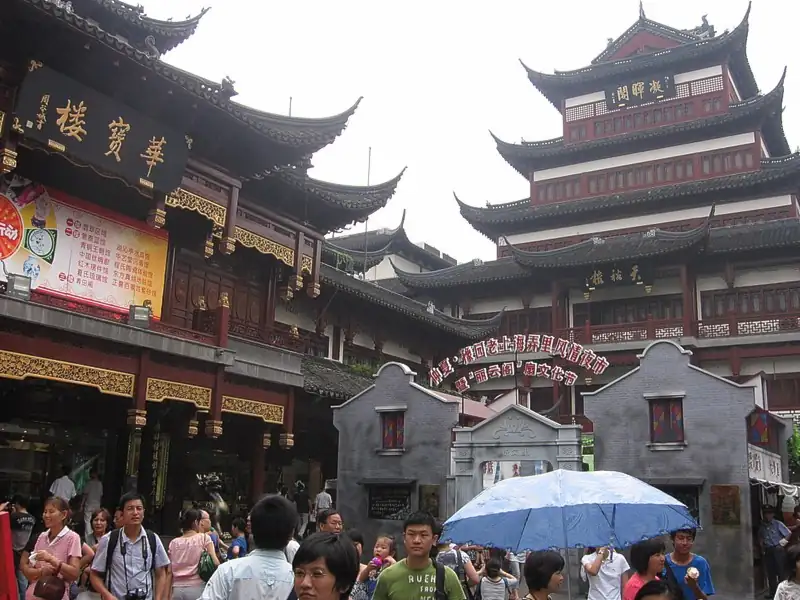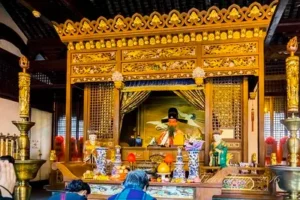The city god temple of Shanghai is a key cultural and historical site. It celebrates Shanghai’s rise to a city and honors three Chinese figures as the city gods. With a history over 600 years, it’s a big part of Shanghai’s growth, serving as a religious site and symbol of prosperity.
In the heart of Shanghai, the city god temple is a top spot for cultural exploration. It spans approx. 3000 square meters, with nine halls like the Grand Hall and Yuanchen Hall. It offers a unique mix of history, culture, and spirituality, making it a memorable visit. Let’s dive into what makes this temple special!

What is the City God Temple?
The City God Temple, also known as Chenghuang Miao, is a famous temple in Shanghai. It’s dedicated to the City God, who is believed to protect the city and its people. This temple is located in the old town area of Shanghai, which is full of traditional Chinese buildings and narrow streets.
The History of the City God Temple of Shanghai
The City God Temple (Chenghuang Miao) in Shanghai is a significant historical and cultural site with a rich history spanning over 600 years. This temple is not only a place of worship but also a symbol of Shanghai’s growth and development.
The City God Temple was originally built during the Ming Dynasty, specifically in the Yongle period (1403-1424). Initially known as the Jinshan God Temple, it was dedicated to the spirit of Jinshan, an island off the coast of Shanghai.
The temple was established to honor Huo Guang, a revered chancellor from the Han Dynasty, who is considered one of the three city gods worshipped at this site.
Over time, the temple gained importance as it became associated with the protection and prosperity of Shanghai. Later It was officially converted into the City God Temple, marking its dedication to safeguarding the city and its residents.
During the Qing Dynasty (1644-1912), the City God Temple reached its peak popularity. The temple complex expanded significantly, It became a vibrant center for both spiritual activities and commerce, attracting many visitors who came to pray for good fortune and safety.
The bustling streets surrounding the temple transformed into a lively marketplace filled with shops and stalls selling various goods.
The temple was not just a religious site; it also played a vital role in community life, with locals flocking to celebrate festivals and participate in temple fairs.
The City God Temple faced severe challenges during the Cultural Revolution (1966-1976), when many religious sites were targeted for destruction.
The temple was closed, and its halls were repurposed for other uses, including as a jewelry shop. Many statues and artifacts were damaged or removed during this tumultuous period.
In 1994, after years of neglect, the temple was restored and reopened as a Taoist temple under the management of the Shanghai Taoist Association. This restoration marked a significant revival of religious practices in Shanghai.
Further renovations took place between 2005 and 2006, leading to the current structure we see today. The temple now serves as an important cultural heritage site, attracting tourists from around the world.
The City God Temple is dedicated to three significant figures known as city gods:
Huo Guang: A chancellor during the Han Dynasty, he is remembered for his honorable actions in government and is regarded as a protector of Shanghai.
Qin Yubo: A civil servant during the late Yuan Dynasty who resisted serving at court but eventually did so under Emperor Hongwu. His dedication to his hometown earned him recognition as a city god.
Chen Huacheng: A general from the Qing Dynasty who defended Shanghai during the First Opium War. His bravery and sacrifice solidified his status as one of the city’s protectors.
The City God Temple of Shanghai stands as a testament to the city’s rich history and cultural heritage. From its humble beginnings as a small shrine to becoming a bustling center of worship and commerce, it reflects the resilience and spirit of Shanghai’s residents through centuries of change.

Architectural Marvel and Layout of the City God Temple of Shanghai
The City God Temple showcases a distinctive traditional Chinese architectural style characterized by:
The temple primarily features wooden buildings, which is typical of ancient Chinese architecture. These structures are designed to withstand the test of time and the elements.
The roofs are adorned with colorful glazed tiles, often in shades of green and yellow, which are not only decorative but also serve to protect the wooden framework beneath.
Visitors can admire exquisite carvings on beams and pillars throughout the temple. These carvings often depict mythical creatures, floral patterns, and scenes from Chinese folklore, showcasing the craftsmanship of ancient artisans.
The use of bright colors is prominent in the temple’s design, creating a lively and welcoming atmosphere. The vibrant reds, greens, and golds symbolize good fortune and happiness in Chinese culture.
The City God Temple covers an area of approximately 3,000 square meters (about 32,300 square feet) and consists of several interconnected halls and courtyards that create a harmonious flow for visitors. Key components of the layout include:
The entrance features a grand gate built in 1535 during the Ming Dynasty. It serves as a ceremonial entry point into the sacred space. The gate is supported by stone pillars and timber beams, with inscriptions that set the tone for reverence.
Upon entering, visitors find themselves in a spacious front square where various activities take place. This area often hosts local performances and gatherings, enhancing the temple’s community spirit.
Huo Guang Palace: This is one of the main halls dedicated to Huo Guang, a prominent figure in Chinese history. Inside, worshippers can pay their respects and offer incense.
City God Hall: Central to the temple complex, this hall is dedicated to the City Gods—Huo Guang, Qin Yubo, and Chen Huacheng. Each deity has its own shrine within this hall, allowing visitors to engage in prayer and reflection.
Additional Halls: The temple includes several other significant halls:
Empress Palace
God of Wealth Hall
Sixty-Year Cycle Palace
Parents Hall
Wenchang Palace
These halls serve various purposes, from honoring different deities to providing spaces for worshippers to connect with their spiritual beliefs.
Beautifully landscaped courtyards connect the different halls. These areas provide tranquil spaces for contemplation amid the bustling atmosphere of the temple complex.
Cultural Significance
The City God Temple is not only an architectural gem but also a cultural hub. It reflects Shanghai’s history as it evolved from a small fishing village into a bustling metropolis.
The surrounding area has transformed into a vibrant marketplace filled with shops selling traditional crafts, snacks, and souvenirs. This blend of spirituality and commerce makes the temple a unique destination for both locals and tourists.
Festivals and Rituals at the City God Temple of Shanghai
One of the most important festivals at the City God Temple is the Sanxun Festival. This festival celebrates the day when the City God is believed to inspect his people. During this time, nearly all the people of Shanghai come to the temple to burn incense and worship the City God. The entire area is decorated with red lanterns, creating a festive atmosphere.
The City God Temple is a popular destination during the Chinese New Year celebrations. People visit the temple to pray for good fortune and prosperity in the coming year. The temple and its surroundings are beautifully decorated, and various cultural performances and activities take place.
Another significant festival celebrated at the temple is the Mid-Autumn Festival. People come to the temple to offer mooncakes and other traditional foods to the gods. The temple grounds are filled with lanterns, and there are often performances of traditional Chinese music and dance.
The temple is also a center for Taoist ceremonies and rituals. These ceremonies are conducted by resident Taoist priests and include chanting, music, and other traditional practices. They are an important part of the temple’s spiritual life.

Visiting the Temple
The City God Temple is located at 249 Fangbang Middle Rd, 四牌楼 Huangpu, Shanghai, China, 200000. It’s open every day from 8:30 AM to 4:30 PM, and the entrance fee is only around CNY 10.
As you explore the temple grounds, you’ll notice many locals engaging in traditional rituals like burning incense or making offerings. This creates a peaceful atmosphere that allows visitors to reflect on their own thoughts and feelings.
What Can You See There?
When you visit the City God Temple, you’ll find many interesting things to see and do:
The temple is a great example of traditional Chinese architecture. You’ll see red walls, curved roofs, and intricate carvings everywhere.
Inside the temple, there are many statues of gods and goddesses. People come here to pray and make offerings.
Right next to the temple is the Yuyuan Garden, a beautiful classical Chinese garden with ponds, rockeries, and pavilions. It’s a peaceful place to relax and enjoy nature.
The area around the temple is full of shops and food stalls. You can buy souvenirs, try delicious street food, and experience the local culture.
You May Also Like: ⇓
- Shankh Monastery: A Treasure of Mongolia
- Amazing Chaukhtatgyi Buddha Temple in Yangon, Myanmar
- Remarkable Burmese Buddhist Temple in Singapore
- Famous Santa Cruz Church: A Noted Landmark of Bangkok
- Outstanding Yasaka Pagoda: A Timeless Landmark in Kyoto
Final Thoughts
As we wrap up our journey through the City God Temple of Shanghai, we see the city’s deep cultural roots. This temple’s long history shows how Shanghai keeps its traditions alive. It beautifully mixes old and new.
Outside the temple, places like Yuyuan Garden and the historic Bund show Shanghai’s cultural variety. The city’s skyline, with its mix of old and new, is a sight to behold. Shanghai’s food, arts, and entertainment also show its rich cultural scene.
When visitors leave the City God Temple, they take with them a deep respect for Shanghai’s culture. This respect inspires them to learn more about the city’s history and traditions. It encourages them to explore the stories that make Shanghai so unique.
1 thought on “City God Temple of Shanghai”